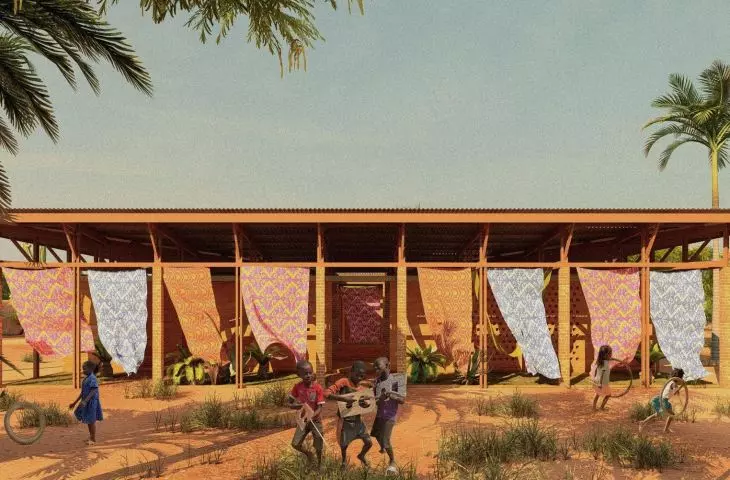This year's theme of the Kaira Looro competition was the design of aChildren's Home in Senegal. A team from Wroclaw University of Technology, consisting of: Wojciech Bandyk, Krystian Cięciwa, Roksana Gleizner and Agnieszka Laska. The students paid special attention to design simplicity, focusing on natural materials and involvement of the local community.
The competition task was to design a facility in the village of Baghere that would support activities for children at risk of malnutrition by, among other things, providing food, developing hygiene and health care awareness programs, meeting with pediatricians and social workers, as well as providing a roof over patients' heads and training community nurses. According to the regulations ,the one-story building of 250 square meters should be easy to construct and created from natural or recycled materials.
The walls of the building were made of red clay
© Wojciech Bandyk, Krystian Cięciwa, Roksana Gleizner, Agnieszka Laska
idea of the team from Wroclaw University of Technology
The competition awarded three Grand Prizes, two Honorable Mentions and five Special Mentions - results and more information can be found here. Although the project by Wojciech Bandyk, Krystian Cięciwa, Roksana Gleizner and Agnieszka Laska did not make the finals, the concept of the team from Wroclaw University of Technology deserves attention.
We are a team that cares deeply about human rights and the protection of human life. This is also the reason why we decided to take part in this competition, which inspired us about what we wanted the building to look like. At the beginning, we talked to each other about what problems could be solved by building a Children's Home, and here are the most important ones: lack of health care, poverty, low levels of education, lack of access to drinking water, food and electricity. The fact that there are people all over the world who struggle so much to live from day to day is devastating. Naturally, we wanted our project to represent the local community and gradually grow with the users and their needs, the students say.
detail and axonometry
© Wojciech Bandyk, Krystian Cięciwa, Roksana Gleizner, Agnieszka Laska
simple idea
The most important part was to find a good inspiration that could push us forward with our assumptions. Our choice may seem obvious or trivial, but we believe that the simplest ideas can be realized best, the authors add.
The Children's House has a simple form
© Wojciech Bandyk, Krystian Cięciwa, Roksana Gleizner, Agnieszka Laska
The students decided to design the building on a rectangular plan with simple material solutions referring to the surrounding buildings. Their inspiration came from architecture by Diébédo Francis Kéré, this year's winner of the Pritzker Prize. As the students say - his designs easily solve the most important issues, meet the criteria of functionality and focus their attention on the use of readily available materials, while satisfying aesthetically.
projection
© Wojciech Bandyk, Krystian Cięciwa, Roksana Gleizner, Agnieszka Laska
The projection of the Children's House was developed on a grid plan composed of squares 190 cm wide. In the space between the warehouse and the recreation room there is a rainwater tank. The designed building consists of an inpatient room with eight beds (places for children in need of medical care), a warehouse, a semi-open space in the form of an atrium, intended for meetings of the local community, an administrative space, a play space, a locker room and a toilet.
A playroom, with a rainwater tank in the center
© Wojciech Bandyk, Krystian Cięciwa, Roksana Gleizner, Agnieszka Laska
natural materials
The authors wanted the building to represent the village community and relate to its local architecture as much as possible. For this reason, they narrowed down the choice of materials to those that were as natural, ecological and easy to use and install as possible. The main construction materials are red clay and rosewood planks.
To createrammed earth (clay) walls, a mixture of red clay and sand must be used, which are then placed and compacted between a formwork made of planks to create a distinctive striped pattern, the designers explain.
The building's foundations were made of stones and iron rods covered with concrete, forming a building rim. When designing the roof truss, the team from Wroclaw University of Technology decided to use wood - beams and planks form the rafters, battens and counter-battens, on which the sheet metal is laid to form the roof. Such a roof is a popular solution in the region.
The patterned fabrics were made by the local community
© Wojciech Bandyk, Krystian Cięciwa, Roksana Gleizner, Agnieszka Laska
patterned and colorful accents
Colorful fabrics, created by the local community, are hung throughout the building. The fabrics were also used to create recreational swings for children. Meanwhile, broken ceramic tiles were used by students to create patterns on the floor.
The building's muted colors allude to nature and the surroundings, while the bright and cheerful fabric patterns are meant to introduce a cozy, warm atmosphere in the interiors.
One of the interiors of the Children's House - the walls are decorated with hand reflections
© Wojciech Bandyk, Krystian Cięciwa, Roksana Gleizner, Agnieszka Laska
On the walls of the building, we have provided a place for children 's handprints to be reflected with colorful paints, so that the youngest children have a sense of creating their own space together, the students add.
Also read about the Children's House proposal by Alicja Bakalarska, Julia Ciężar and Matylda Wolska, students from Warsaw University of Technology.




































